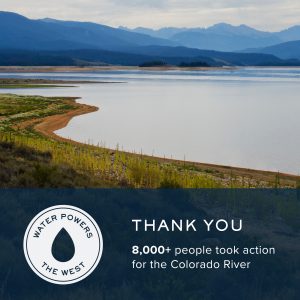
Public Comment Period for WaterSMART Grant Criteria Closes with Thousands of Comments in Favor of Prioritizing Projects that Keep Water in Our Rivers
National conservation and sportsmen groups applauded recent proposed changes from the Bureau of Reclamation intended to prioritize projects that keep water in the Colorado River when evaluating potential recipients for water conservation grants.
This comes at the conclusion of the 30-day public comment period to review and provide feedback on the Bureau of Reclamation’s proposed changes to the WaterSMART Water and Energy Efficiency Grants Evaluation Criteria. WaterSMART is an initiative of the Bureau of Reclamation to improve water conservation and help water resource managers identify strategies to bring the demand for water in balance with supply.
The proposed changes to the evaluation criteria for these WaterSMART grants will give greater consideration to projects that offer multi-sector benefits, especially projects that keep water in rivers, or return water to rivers, and will encourage greater collaboration between on-farm and off-farm efforts.
“With increased demand and a 15-year drought depleting the Colorado River and threatening the recreational activities we love, it’s more important than ever that we protect the river and the wildlife that depend on it. These proposed changes would help maximize conservation efforts and improve water efficiency – while also protecting the vibrant fish and wildlife we all enjoy,” said Scott Yates, Director of Western Water and Habitat Program at Trout Unlimited.
“The proposed WaterSMART criteria are key to building a sustainable and drought-resilient water future. Restoring the health of our rivers and streams is integral to reducing the risk of water shortages, creating flexibility in water management, and improving the reliability of water systems,” said Matt Niemerski, Director of Western Water and Public Lands Policy at American Rivers.
“While WaterSMART grants have successfully conserved water across the West, very few projects commit to returning that conserved water to rivers,” said Bart Miller, Healthy Rivers Program Director at Western Resource Advocates. “The proposed changes to the evaluation criteria are a necessary step forward to ensure our rivers can support everyone and everything that depends on them.”
“The proposed criteria recognize the value that improved flows have for hundreds of bird species, countless wildlife, and the local communities that depend on a healthy Colorado River. It’s pretty simple: when the environment benefits, so do people,” said Karyn Stockdale, Director of the National Audubon Society’s western water program.
“These proposed WaterSMART criteria are exciting because they serve all water users – agriculture and municipalities alike – while also benefiting the environment,” said Kevin Moran, Senior Director of Western Water at Environmental Defense Fund, “These changes illustrate real promise and progress in our ongoing efforts to bring together diverse groups of stakeholders to make the West more drought-resilient.”
“The public comment period generated more than 8,000 comments in just 30 days. It’s clear that the public is engaged in this issue and cares about the outcomes of these grants,” said Melinda Kassen, interim director of the Center for Water Resources at the Theodore Roosevelt Conservation Partnership. “We all want to ensure the grant recipients’ projects result in on-the-ground benefits and build a more sustainable and resilient Colorado River for sportsmen to enjoy for years to come.”
“Given the confluence of scarcity in the West, aging infrastructure, and changing weather patterns, we commend Reclamation for making changes to the WaterSMART Program that will support integrated, watershed-scale solutions that benefit multiple water use sectors,” said Taylor Hawes, Director of The Nature Conservancy’s Colorado River Program. “This is an important step in the right direction that can benefit the millions of Americans who depend on the Colorado River for drinking water, food production, and recreation, while also benefiting the river itself.”
WaterSMART provides grants to improve community water delivery systems and infrastructure. The grants have been a powerful tool for spurring collaborative, locally-led water conservation projects. The 243 grants issued from 2010 to 2015 went to projects that save an estimated 557,000 acre-feet of water per year—enough to provide water for more than 2.2 million people.
Following the conclusion of the public comment period, the Bureau of Reclamation will work to finalize grant evaluation criteria before publishing the funding opportunities for WaterSMART in November.
